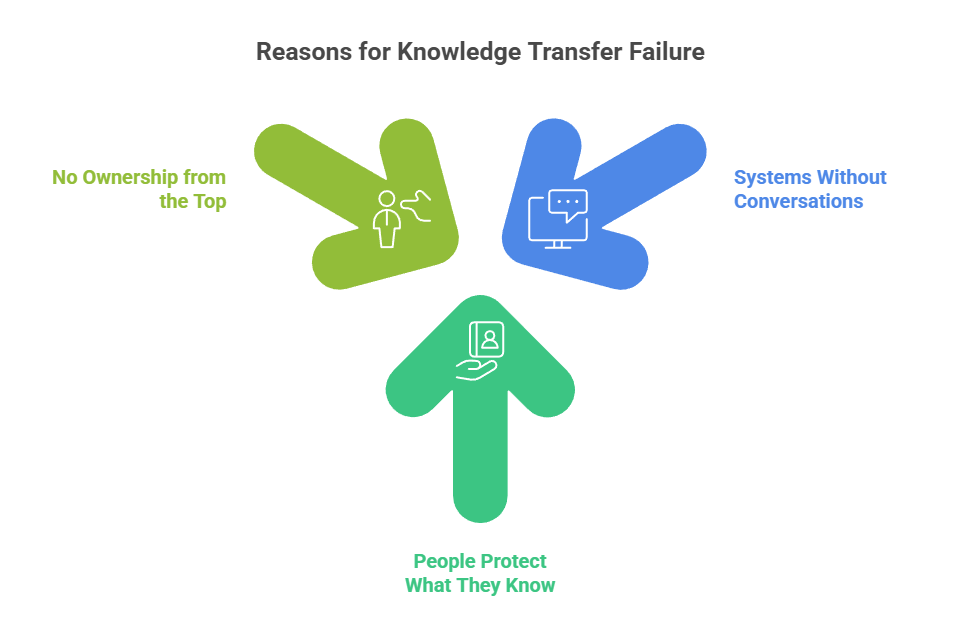You’ve got robust documentation, a seasoned HR team, and processes that look bulletproof on paper. But when someone key leaves, your knowledge transfer efforts are tested—and often fall short. Teams stall, decisions bottleneck, and you’re back in meetings asking questions you thought were answered months ago.
You’re not alone. It’s a silent frustration many CEOs face: why does knowledge seem to evaporate the moment someone walks out the door? And if everything is written down, why does the business still feel like it’s running on tribal knowledge?
This isn’t just a systems problem—it’s a leadership one. And recognising that is your first step towards fixing it.
In this article, you’ll learn exactly why knowledge transfer often fails, the hidden gaps most executives miss, and what you need to do as a leader to make knowledge truly stick inside your organisation.
Why Documentation Alone Doesn’t Work

You can have a perfectly organised wiki, an extensive library of SOPs, and still watch your teams flounder when someone leaves. Why? Because documentation isn’t knowledge—it’s data. And without the right context, it’s often useless.
Think about it: most documentation captures what to do, sometimes how to do it—but rarely why it’s done that way. The nuance, the rationale, the strategic trade-offs—those live in people’s heads. And when those people go, so does that context.
It’s also a matter of trust. Most employees don’t learn by reading a document—they learn by watching, asking, and doing. If your culture doesn’t foster active mentoring or safe spaces for knowledge sharing, your documents become digital dust collectors.
Documentation is necessary, but it’s not sufficient. It’s the scaffolding—not the building.
The Three Core Reasons Knowledge Transfer Fails
If you’ve got documentation, tech, and good people—but knowledge still isn’t sticking—then the problem usually falls into one (or more) of these three buckets:

1. Systems Without Conversations
Processes are great. Platforms are useful. But knowledge isn’t passive—it’s dynamic. It evolves through conversation, not just checklists. When systems replace dialogue instead of supporting it, knowledge stays shallow.
You might have a killer onboarding doc, but unless your new hire has space to ask, challenge, and explore the reasoning behind it, they’re just memorising, not understanding.
2. People Protect What They Know, Hindering Knowledge Transfer
It’s not always malicious. Sometimes it’s fear—fear of being replaced, losing relevance, or simply not being appreciated. When people feel insecure, they hold back. And when knowledge is power, hoarding it becomes a survival tactic.
Leaders often miss this because it hides in plain sight: polite meetings, handover calls, surface-level walkthroughs. But if people don’t feel psychologically safe or valued, real transfer won’t happen.
3. No Ownership from the Top in Knowledge Transfer
If knowledge transfer is seen as an HR or IT initiative, it will fail. Full stop.
This is a leadership issue. When leaders don’t model transparency, storytelling, and curiosity, no one else will. When transitions are rushed or treated like admin, your teams mirror that energy.
Ownership from the top means treating knowledge like a strategic asset—not a checklist item.
The Leadership Gap in Knowledge Transfer
Here’s the hard truth: knowledge transfer breaks down because leaders let it.
Not intentionally, of course. But when you’re moving fast, managing risk, and juggling board pressure, it’s easy to assume knowledge flows naturally. It doesn’t. It needs to be designed—and led.
If you treat knowledge transfer like a backend process, your teams will do the same. But if you treat it as critical to scale, resilience, and innovation, that mindset will filter down.
Ask yourself:
- When someone exits, is the handover meaningful—or rushed?
- Do people have time and incentives to mentor others?
- Are you telling stories, not just giving instructions?
- Do you celebrate collaboration—or reward lone wolves?
This isn’t about micromanaging documentation. It’s about setting the tone. When leaders prioritise knowledge sharing—by being transparent, by encouraging shadowing, by slowing down to explain decisions—everyone else does too.
The real gap isn’t in your systems. It’s in the behaviours your leadership team is modelling.
How to Build a Culture of Embedded Knowledge
Creating a culture where knowledge actually sticks doesn’t happen through process updates—it happens through people. And it starts with how you lead.
Here’s what that looks like in practice:
1. Prioritise Context, Not Just Content in Knowledge Transfer
Don’t just tell people what to do—explain why. Context is what turns actions into understanding. When teams know the “why,” they’re better at making decisions when things shift.
In every strategy session, product review, or team debrief, ask yourself: Are we just sharing information, or are we sharing meaning?
2. Make Shadowing the Norm
Knowledge lives in nuance. Let people learn by watching others operate in real time. Senior team members should expect to have others shadow them. It should be a norm, not an exception.
And don’t wait for a resignation to make this happen—build it into your culture before it’s needed.
3. Reward Teaching, Not Just Doing
If your recognition and reward systems only favour execution, people will optimise for output—not sharing. Flip that. Call out great mentors. Track how knowledge is being passed, not just tasks completed.
This one shift turns “knowledge hoarding” from an unconscious behaviour into a visible blocker to growth.
4. Lead by Example
If you want a culture of openness and learning, you need to model it. Talk through your decisions. Share your own failures and learnings. Make it normal to not have all the answers, and powerful to share what you’ve learned along the way.
Checklist for Fixing Knowledge Transfer
If you’re serious about fixing knowledge transfer in your organisation, here’s a practical checklist you can start using today. These are leadership-level shifts that create real, lasting change.
1. Audit Critical Knowledge Areas for Knowledge Transfer
- Identify which roles carry “tribal” knowledge.
- Map out what’s documented versus what’s lived experience.
- Ask: If this person left tomorrow, what would break?
2. Create Redundancy, Intentionally
- Assign backups or “second chairs” for key roles.
- Rotate responsibilities periodically to spread expertise.
- Make knowledge-sharing a formal part of role expectations.
3. Build Reflection Into Your Workflows
- After every major project or initiative, run a retrospective.
- Capture not just results, but lessons, trade-offs, and decision rationale.
- Share these learnings widely—don’t let them stay siloed in one team.
4. Incentivise Teaching
- Set KPIs or recognition for mentorship and knowledge sharing.
- Reward those who build others up, not just those who hit targets.
5. Lead Out Loud
- Be open about your own decision-making process.
- Share strategic thinking, not just end results.
- Ask questions that invite insight from across the business.
This isn’t a one-time fix. It’s a leadership muscle that needs to be flexed consistently.
Lead Knowledge, Don’t Just Manage It
Knowledge transfer isn’t broken because your tools are wrong. It’s broken because it’s being treated like a task, not a leadership responsibility.
The failure isn’t in the absence of documentation—it’s in the absence of deliberate, embedded knowledge culture. And culture starts at the top.
When you lead with transparency, prioritise teaching, and build systems that reflect your values—not just your processes—you create an organisation that doesn’t just retain knowledge, it multiplies it.
This isn’t about adding more work. It’s about leading smarter. And if you get it right, you won’t just protect your business from disruption—you’ll set it up to scale with resilience and clarity.




